
J.M. Wendt Australian Silver Napkin Ring and Butter Knife
Two J.M. Wendt Australian silver items, Joachim Matthias Wendt (Adelaide), c1880s comprising a napkin ring of plain circular form, stamped with crown, 'J. M. Wendt Adelaide' and lion passant, and a butter knife with foliate engraved blade, stamped with…

Silver napkin rings by J M Wendt in leather case
Pair of silver napkin rings in presentation box by J M Wendt in leather case, diameter 4.5 cm Wgt:74g. Provenance: Vizard Foundation collection

Australian silver christening mug by J. M. Wendt, Adelaide origin
Australian silver christening mug by J. M. Wendt, of Adelaide, height 7 cm, wt135 grams. Provenance: Vizard Foundation collection

Antique Australian Silver Trophy Cup with Grape Decoration, 1881
Joachim Matthias Wendt of Adelaide, antique Australian silver trophy cup with repousse grape decoration, engraved 'Mt. Gambier a. & H. Society spring show 1881, presented by Messrs. J. & H. Morriss for best Bull'. Perpetual trophy engraved with several…

Australian Silver Equine Ewer by J.M. Wendt, 19th Century
Joachim Matthais Wendt of Adelaide, stunning Australian silver equine themed ewer, 19th century, stamped 'J.M. Wendt, Adelaide' with pictorial marks, 35 cm high, 820 grams

Australian Silver Whisky Hip Flask in Leather Case, 7.5cm, 315g
J.M. Wendt Australian silver Whisky hip flask. In leather case, height 7.5 cm W315g, flask

1909 SA Angus Cup Silver Trophy - J.M & E.F O'Sullivan
South Australian Angus cup silver trophy, rare, 1909 Royal Agricultural and horticultural Society of South Australia Winners, solid silver twin handled trophy for 'Three year old Entire' won by J.M and E.F O'Sullivan, September 1909, stamped Wendt with…

Wendt's Sterling Silver Trophy with Figural Horse Top
Silver trophy, hallmarked sterling silver, late 19th century Wendt's, by Joachim Matthias Wendt (1830-1917) twin handle with etched tree trunk base and figural horse to top, etched camel to back, 1893 birthday Cup- won by Slow Tom, height 43.5 cm, weight…

Adelaide Hunt Club Steeplechase Trophy Ewer, 1889
J. M. Wendt Colonial Australian silver trophy ewer engraved 'Adelaide Hunt Club Steeple Chasers, 1889, Drag Cup Presented by W. A. Horn Esq. M.P. Won by Pilot. Ridden by Mr. T. McFie, Distance Three Miles, Time 7 Min 14 Sec' stamped 'J. M. Wendt,…

Victoria Crystal Vase with Sterling Silver Collar
Victoria cut crystal etched vase, star etched crystal with sterling silver collared base with embossed Wendts stamp

South Australian Colonial Silver Christening Mug
Christening mug, South Australian colonial silver by J.M.Wendt Adelaide with mount Gambier mark to base., height 7.2 cm, width 116.8g

1902 Australian Water Polo Trophy by J.M. Wendt
Early 20th century Australian sterling silver water polo trophy, by J.M Wendt, height 19 cm, Wt 591grams inscribed 'South Australian polo Association Challenge Cup, presented by R Barr-Smith and won by Adelaide Polo Clu, 1902'

Colonial Silver Waterloo Cup Trophy by J. M. Wendt
J. M. Wendt, 'Waterloo Cup' Colonial silver trophy cup, engraved 'S. A. Coursing club, Waterloo cup, presented by Mr T. Barr Smith, won by Mr C. Mallen's Br D Mozart, by Faultfinder, Buckland park, 1889', stamped 'J. M. Wendt, Adelaide' with crown and…

Colonial Silver Equestrian Trophy Cup and Cover by J.M. Wendt
A Colonial silver equestrian trophy cup and cover attributed to J. M Wendt, the cover with horse finial, the bell shaped body having repousse floral wreath to one side and laurel wreath to the reverse, flanked by a pair of scrolled engraved handles,…

Australian Silver Flask by J.M. Wendt, Adelaide, c. 1890
An Australian silver flask by J. M Wendt, Adelaide, plain design with detachable cup, hinged handle. Stamped 'J. M. Wendt Jeweller and Silversmith Adelaide broken Hill', sovereign head/crown/lion passant. Cap with monogram, circa 1890. Provenance: The…

Australian silver knife rests by J.M. Wendt, 19th century
A pair of Australian silver knife rests by J.M. Wendt of Adelaide, 19th century, stamped J.M.W. with Queen's head and lion passant, 8.5 cm across, 115 grams

Wendt Lion Australian Silver Name Brooch - 31mm Length
Australian silver name brooch by Wendt marked reverse Wendt Lion. Approx length 31 mm
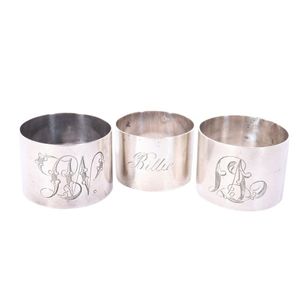
South Australian Sterling Silver Wendt Napkin Rings with Monograms
Wendt napkin rings three South Australian sterling silver hallmarked: J. M. Wendt, Adelaide & Broken Hill. + monograms, height of largest 3.5 cm
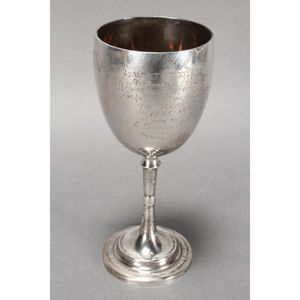
Australian Silver Cricket Cup, c.1885, by Jochim Matthias Wendt
Australian silver cricket cup, c.1885, by Jochim Matthias Wendt, inscribed 'Prospect cricket Club/ presented by/ R Robertson Esq President/ for Highest batting Average/ for Season/ 1885 - 6/ won by/ E Beckwith/ average of 17.5', with funnel shaped bowl,…

Sterling Silver Racing Trophy, Adelaide 1896
Late 19th century, South Australian Colonial period, sterling silver racing trophy by J.M. Wendt Silversmith, Adelaide, inscription presented by the Stewards of the Onkaparinga racing club to the rider of the Winner at the Amateur steeple chase., won by…
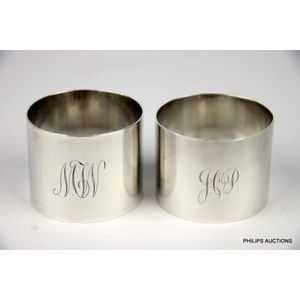
Pair of Wendt Sterling Silver Napkin Rings, Australia, Late 19th Century
A near pair of Australian sterling silver napkin rings, later 19th century, with maker's marks for Wendt (of Adelaide), plain cylindrical rings, both engraved with initials, hallmarked to the interiors, silver weight 70gr

South Australian Sterling Silver Napkin Rings by J.M. Wendt
Wendt: Two sterling silver napkin rings, South Australian, late 19th century, one stamped 'J.M. Wendt Jeweler Adelaide & Broken Hill', the other stamped 'Wendt' with hallmarks, 82 grams total

Australian Silver Knife Rests by J.M. Wendt, 19th Century
A pair of Australian silver knife rest by J.M. Wendt of Adelaide, 19th century stamped J.M.W. with Queen's head and lion passant 8.5 cm across, 115 grams
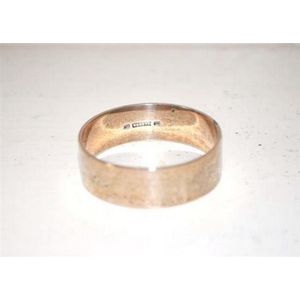
Australian Wendt's Sterling Silver Serviette Ring
An Australian sterling silver serviette ring, maker: Wendt's of Adelaide

Jobson Trophy: Sterling Silver Salver, Broken Hill Engineer's Honor
The Jobson trophy. Very impressive presentation salver, sterling silver hallmarked London 1891, salver on four avian claw & ball feet, central inscription reads: Presented to C Jobson Esq MJCE etc Engineer to the Broken Hill Water Supply as a mark of…
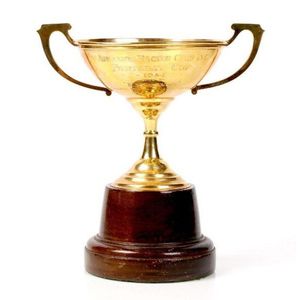
Adelaide Racing Club 1954 Birthday Cup
Adelaide Racing Club trophy cup. 9ct gold, beautifully stepped foot rising to small knob, large bowl with applied twin handles, inscribed, Adelaide Racing Club Inc., Birthday Cup 1954 won by Engraver, Owners Messrs A E & J F Trim & J F Courtnay, marked to…

Sterling Silver Cruet Set with Case and Spoons
Cruet set. Sterling silver hallmarked Birmingham 1947, five piece box set, comprising pair of salts, pair of pepper shakers, mustard pot & three spoons in case, retailed by Wendt 74 Rundle Street Adelaide

Victorian Apostle Spoons with Figural Finials and Presentation Box
A fine pair of Victorian apostle spoons, 1888 London, with maker's marks for John Aldwinckle & Thomas Slater, the elegant spoons with shallow gilt washed circular bowls, with slender shaped stems with bright cut designs to cast upper sections surmounted…

Wendts' Australian Silver Mug for Walker and Hall
Australian silver mug, made by Wendts for Walker and Hall

Rare J.M. Wendt Adelaide Silver Serviette Ring
Australian silver serviette ring with rare mark J.M. Wendt Adelaide and Broken Hill

JM Wendt Sterling Silver Napkin Ring from Adelaide
An early Australian sterling silver napkin ring, by JM Wendt, Adelaide

Melba's Silver Key, Wendt's 1927
A silver key, Wendt's, 1927 the silver key bearing the inscription Presented to Dame Nellie Melba, 9.11.27, On her opening the completion of the Queen's Home, length approximately 73 mm, signed Wendts, case by Wendts Jewellers. Property from the…

Pair of Wendt Sterling Silver Napkin Rings
Two Australian Wendt sterling silver napkin rings, both hallmarked the tallest 33 cm marked JM Wendt (jeweler Adelaide and broken Hill), engraved MSL, the other marked Wendt engraved LB, 64 grams approx in total.

Australian Silver Cup by Jochim Wendt, circa 1880
An Australian silver cup by Jochim Matthis Wendt, Adelaide, circa 1880
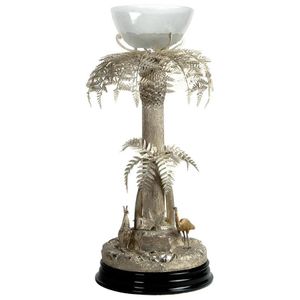
Adelaide Presentation Palm-Tree Centrepiece by J.M. Wendt, 1880
A fine and important sterling silver presentation palm-tree centrepiece by Joachim Matthias Wendt of Adelaide, Australian, circa 1880, Inscribed ?Presented to The Mayoress of Adelaide Mrs J. Lavington Bonython, by the citizens in recognition of many…

Australian Wendt Silver Napkin Ring with Maker's Marks
Antique Australian silver Wendt napkin ring, with silver and makers marks, 55 grams

Antique Wendt Silver Christening Mug, 1876 Engraved
Antique Australian silver Wendt christening mug, engraved with initials and date 1st Sept 1876, with silver and makers marks - JMW (for Jochim Matthias Wendt of Adelaide), 9.5 cm high approx. 155 grams

Australian Ruby Box by Wendt, Early 20th Century
A fine Australian sterling silver and ruby box, early 20th century, with maker's mark for Wendt of Adelaide, with Crown and lion. The circular cushion shaped box with a hinged horseshoe lid with grain set rubies forming a monogram, and having a matte gilt…

Australian Silver Centrepiece with Indigenous Motifs
An Australian silver centrepiece, probably by Jochim Matthias Wendt, Adelaide, 1875, on a large domed chased base applied with a bronze indigenous hunter, a kangaroo and an emu, silver tree fern and centre twisted tree trunk issuing leafy branches, turned…
 Loading more...
Loading more...